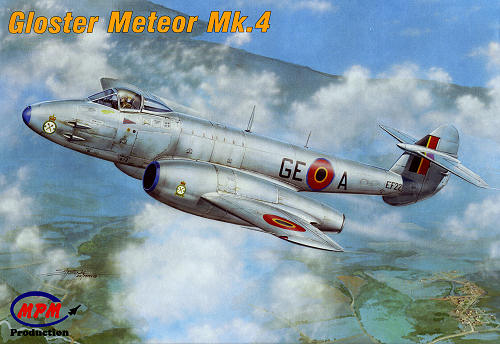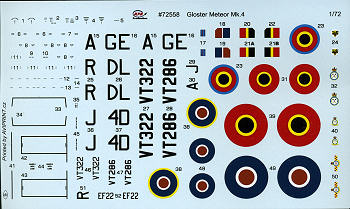
MPM 1/72 Meteor Mk.4
| KIT #: | 72558 |
| PRICE: | $41.00 SRP ($33.15 from GreatModels ) |
| DECALS: | Three options |
| REVIEWER: | Scott Van Aken |
| NOTES: |

| HISTORY |
The Meteor F 4, and subject of this kit, went into production in 1946, by which time there were 16 RAF squadrons equipped with Meteors. The first F 4 prototype flew on 17 May 1945. The F 4 had the Rolls-Royce Derwent 5 engines (a smaller version of the famous Nene), the wings were 86.4 cm shorter than the F 3 and had blunter tips (derived from the world speed record prototypes), a stronger airframe, fully pressurized cockpit, lighter ailerons (to improve maneuverability) and rudder trim adjustments to reduce snaking. The F 4 could also be fitted with a drop tank under each wing while experiments were performed with carriage of underwing stores and also in lengthened fuselage models. The F 4 was 170 mph faster than the F 1 at sea level (585 against 415), although the reduced wings impaired its rate of climb.
Because of the increased demand, F 4 production was divided between Gloster and the Armstrong Whitworth factory at Bagington. The majority of early F 4s did not go directly to the RAF: 100 were exported to Argentina (and saw action in the 1955 revolution, one being shot down on 16 September 1955 near Rio de Santiago) while in 1947, only RAF Nos. 74 and 222 Squadrons were fully equipped with the F 4. Nine further RAF squadrons were upgraded over 1948. From 1948, 38 F 4s were exported to the Dutch, equipping four squadrons (322, 323, 326 and 327) split between bases in Soesterberg and Leeuwarden until the mid-1950s. In 1949, only two RAF squadrons were converted to the F 4, Belgium was sold 48 aircraft in the same year (going to 349 and 350 Squadrons at Beauvechain) and Denmark received 20 over 1949–50. In 1950, three more RAF squadrons were upgraded, including No. 616 and, in 1951, six more. In 1950, a single order of 20 F 4s was delivered to Egypt.
A modified two-seater F 4 for jet-conversion and advanced training was tested in 1949 as the T 7. It was accepted by the RAF and the Fleet Air Arm and became a common addition to the various export packages (for example 43 to Belgium 1948-57, a similar number to the Netherlands over the same period, two to Syria in 1952, six to Israel in 1953, etc.). Despite its limitations - unpressurized cockpit, no armament, limited instructor instrumentation - over 650 T 7s were manufactured.
| THE KIT |
 The MPM kit of the Meteor F.4 now effectively relegates the old Frog kit to the 'easy build' pile. I have to admit being a real fan of stock # F200 and have built many of these kits, in both Frog and Novo releases. I was used to lack of cockpit, the thick gear doors and general heavy handed detail, but now, that is a thing of the past for most of us. The MPM kit of the Meteor F.4 has come at last, bringing with it a full cockpit, some detail when one looks into the intakes, nicely done landing gear and full wheel wells, both wing and belly fuel tanks, and a nice, clear canopy.
The MPM kit of the Meteor F.4 now effectively relegates the old Frog kit to the 'easy build' pile. I have to admit being a real fan of stock # F200 and have built many of these kits, in both Frog and Novo releases. I was used to lack of cockpit, the thick gear doors and general heavy handed detail, but now, that is a thing of the past for most of us. The MPM kit of the Meteor F.4 has come at last, bringing with it a full cockpit, some detail when one looks into the intakes, nicely done landing gear and full wheel wells, both wing and belly fuel tanks, and a nice, clear canopy.
The plastic itself is fully up to MPM's current standards. Detail is crisply engraved and I only found a bit of flash on some of the parts. It is obvious that the wing sprue is also used for the F.8 version as there are larger intake openings (not used on the F.4). Couple of things I'd like to have seen. One is a separate, sliding canopy to show off the interior. The other is that I'm less than jazzed about the outer wings being separate moldings. I would have thought tha t they could have been done with the engine and inner section. It sure would have taken the worry out of getting the outer dihedral correct. But then, it would have limited the outer wing panel options so that is probably why it was done.
t they could have been done with the engine and inner section. It sure would have taken the worry out of getting the outer dihedral correct. But then, it would have limited the outer wing panel options so that is probably why it was done.
Instructions are well done with Gunze paint references. There are three markings options, all of them in overall 'High Speed Silver' lacquer. These planes were not unpainted metal. You have options for three planes. Two of them are RAF, from 74 and 92 Squadron. These were the days of codes, not the colorful unit bands. The third option is 349 Squadron, Belgian Air Force as shown on the box art. There were a bunch of other nations and RAF squadrons that flew this plane. Optional markings should not be very difficult to find if you don't like what is provided. Aviprint does the decals and they appear to be superb.
| CONCLUSIONS |
With a parts count that has to be four times the old Frog kit, you know that the detail is there. I can easily see how this will prove to be a very popular kit.
| REFERENCES |
August 2009
You can find this and a lot of other great kits and accessories at www.greatmodels.com
If you would like your product reviewed fairly and fairly quickly, please contact the editor or see other details in the Note to Contributors.